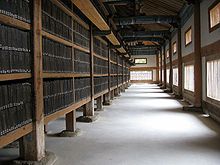- Chinese Buddhist canon
-
Part of a series on
Buddhism
Dharma or concepts
Four Noble Truths
Five Aggregates
Impermanence
Suffering · Non-self
Dependent Origination
Middle Way · Emptiness
Karma · Rebirth
Samsara · CosmologyPractices
Three Jewels
Noble Eightfold Path
Morality · Perfections
Meditation · Mindfulness
Wisdom · Compassion
Aids to Enlightenment
Monasticism · LaityNirvāṇa
Four Stages · Arahant
Buddha · BodhisattvaTraditions · Canons
Theravāda · Pali
Mahāyāna · Chinese
Vajrayāna · TibetanThe Chinese Buddhist Canon (大藏經 Dàzàngjīng) (Japanese: 大蔵経 Daizōkyō; Korean: 대장경 Daejanggyeong; Vietnamese: Đạitạngkinh) refers to the total body of Buddhist literature deemed canonical in Chinese, Japanese, Korean, and Vietnamese Buddhism. The traditional term for this canon is Dàzàngjīng (大藏經), which means the "Great Treasury of Sūtras."
Contents
Contents
The Chinese Buddhist canon includes Āgama, Vinaya and Abhidharma texts from Early Buddhist schools, as well as the Mahāyāna sūtras and scriptures from Esoteric Buddhism.
Versions
There are many versions of the canon in East Asia in different places and time. An early version is the Fangshan Stone Sutras (房山石經) from the 7th century.[1] The earlier Lung Tripitaka (龍藏) and Jiaxing Tripitaka (嘉興藏) and new tripitakas are still completed in printed form. The complete woodblocks are the Tripiṭaka Koreana and the Chenlong Tripitaka. The Tripiṭaka Koreana or Palman Daejanggyeong was carved between 1236 and 1251, during Korea's Goryeo Dynasty, onto 81,340 wooden printing blocks with no known errors in the 52,382,960 characters. It is stored at the Haeinsa temple, South Korea.[2]
One of the most used version is Taishō Shinshū Daizōkyō (Taishō Tripiṭaka, 大正新脩大藏經).[3] Named after the Taisho era, a modern standardized edition published in Tokyo between 1924 and 1934. It is the only punctuated tripitaka.[4] It is based on older Japanese versions, which are based on the Tripiṭaka Koreana[citation needed], and compared to many other versions of the individual texts in Japan. There are a few Dunhuang manuscripts. It contains 100 volumes.
The Zokuzokyo (Xuzangjing) (卍續藏) version, which is a supplement of another version of the canon, is often used as a supplement for Buddhist texts not collected in the Taishō Tripiṭaka. The Jiaxing Tripitaka is a supplement for Ming dynasty and Qing dynasty Buddhist texts not collected.,[5] and a Dazangjing Bu Bian (大藏經補編) published in 1986 are supplements of them.[6]
The Tibetan Manuscripts in the Tripitaka Sinica (中華大藏經–漢文部份 Zhonghua Dazangjing: Zangwen bufen), a new collection of canonical texts, was published by Zhonghua Book Company in Beijing in 1983-97, with 107 volumes of literature, are photocopies of early versions[7][8] and including many newly unearthed scriptures from Dunhuang.[9] There are newer Tripitaka Sinica projects.[10]
Languages
The Mi Tripitaka (蕃大藏經) is the Tangut canon.[11] It is not known if the Khitan edition is in Chinese or Khitan, as all Khitan Buddhist texts found are in Chinese. The Taishō edition contains classical Japanese works. The Dunhuang edition contains some works in old Western Regions languages.[12] The Tripitaka Sinica mentioned above features a Tibetan section.
Non-collected works
A number of apocryphal sutras composed in China, composed stories such as the Journey to the West and Chinese folk religion texts are excluded in the earlier canons.[13][14][15][16][17] Modern religious and scholar works are also excluded but they are published in other book series.
Translations
See also: Chinese translation theorySamples
Notes
- ^ 房山石经的拓印与出版
- ^ http://whc.unesco.org/archive/advisory_body_evaluation/737.pdf
- ^ 刊本大藏經之入藏問題出探 A Preliminary Study on the Question of which Texts were Incorporated in the Blockprint Editions of the Tripitaka
- ^ 中国努力打造《新编大藏经》工程
- ^ 工具書‧叢書‧大藏經
- ^ 张新鹰:《中华大藏经》——一项重大的佛教文化工程
- ^ 《金藏》劫波一部佛经的坎坷路
- ^ 說不盡的《趙城金藏》
- ^ 略谈《中华大藏经》在汉文大藏经史上的地位
- ^ 《中华大藏经(汉文部分).续编》的特点和结构
- ^ 国图藏西夏文文献的价值
- ^ 怀念北图馆长北大教授王重民先生
- ^ A Research on the Authenticity of the Bhikhuni Seng Fa from Jiangmi 關於江泌女子僧法誦出經
- ^ 一些伪经(作者:释观清)
- ^ 助印佛经须知
- ^ 涉嫌封建迷信、邪教、伪经伪书、混淆知见的书籍一览
- ^ 果卿居士《现代因果实录》的不实之处- 般若之门
See also
External links
General
- The Chinese Canon(Introduction)
- WWW Database of Chinese Buddhist texts(Book index)
- Chinese Buddhist Tripitaka Electronic Text Collection, Taipei Edition
- Taisho Tripiṭaka, SAT
- East Asian Buddhist Studies: A Reference Guide
- The TELDAP projects as the base of the Integration of Buddhist Archives -- Buddhist Lexicographical Resources and Tripitaka Catalogs as the example
- Digital Database of Buddhist Tripitaka Catalogues
- (Chinese)大藏经研究(Book index)
- (Chinese)佛教《大藏经》34种版本介绍保证网络最全(Book index)
- (Chinese)電子藏經 Extensive list of online tripitakas
- (Chinese)汉文大藏经刊刻源流表(Book index)
- (Chinese)汉文大藏经概述(Book index)
- (Chinese)近三十年新发现的佛教大藏经及其价值(Description of rediscovered texts of the Canon)(Book index)
- (Chinese)历代印本汉文大藏经简介(Description of existing versions of the Canon)
- (Chinese)汉文佛教大藏经的整理与研究任重道远(Description of new versions of the Canon)
Texts
- (Japanese)Machine-readable text-database of the Taisho Tripitaka (zip files of Taisho Tripitaka vol. 1-85)
- (Chinese)CBETA Project(with original text of Taisho Tripitaka vol.1-55, 85; the complete Zokuzokyo/Xuzangjing, and the Jiaxing Tripitaka).
- (Chinese)佛教大藏經(links to big size pdfs)
- (Chinese)藏经楼--佛教导航
- (Korean)Tripitaka Koreana(electronic scans)
- Alternative Source for CBETA
- Buddhist Scriptures in Multiple Languages
Non-collected works
- (Chinese)報佛恩網(A collection of many modern Buddhist works outside the existing canon versions)
- (Chinese)生死书繁简版(Another collection of modern Buddhist works)
- (Chinese)戒邪淫网(Another collection of modern Buddhist works)
- (Chinese)民间佛经(False sutra)
- (Chinese)佛道經典精選(False sutra)
- (Chinese)佛教经文(False sutra)
- (Chinese)慈慇堂 / 佛經(False sutra)
- (Chinese)chaomaeguanim.doc - เว็บบอร์ด พลังจิต ดอทคอม(False sutra)
- (Chinese)常洪的分享空間- Windows Live(False sutra)
- (Chinese)有益眾生持誦的佛經(False sutra)
- (Chinese)重要修行經典整理分享(False sutra)
- (Chinese)观音娘娘家门平安经(False sutra)
- (Chinese)佛说观世音菩萨救苦经(清乾隆年版)(False sutra)
- (Chinese)延命十句觀音經(False sutra)
- (Chinese)保门经(False sutra)
- (Chinese)【新搜】之:【灶皇经】二种(False sutra)
- (Chinese)佛學研究基本文獻及工具書(Book list)
- (Chinese)大藏经(Book list)
- (Chinese)大藏经(Book list)
- (Chinese)佛教大学(Book list)
- (Chinese)中文佛學文獻檢索與利用(Book list)
- (Chinese)工具書‧叢書‧大藏經(Book list)
- (Chinese)Center for Buddhist Studies 國立臺灣大學佛學研究中心(Book list)
- (Chinese)佛教研究之近況(Book list)
- (Chinese)佛書- 佛門網Buddhistdoor - 佛學辭彙- Buddhist Glossary(Book list)
- (Chinese)兩岸佛學研究與佛學教育的回顧與前瞻(Book list)
- (Chinese)当代台湾的佛学研究(Book list)
- (Chinese)佛教资料库网站集锦(修订3版)(Book list)
Categories:- Mahayana sutras
- Tripiṭaka
- Buddhist texts
- Chinese literature
- Chinese Buddhist texts
Wikimedia Foundation. 2010.





